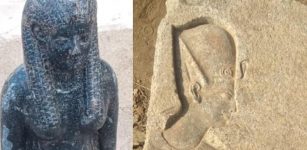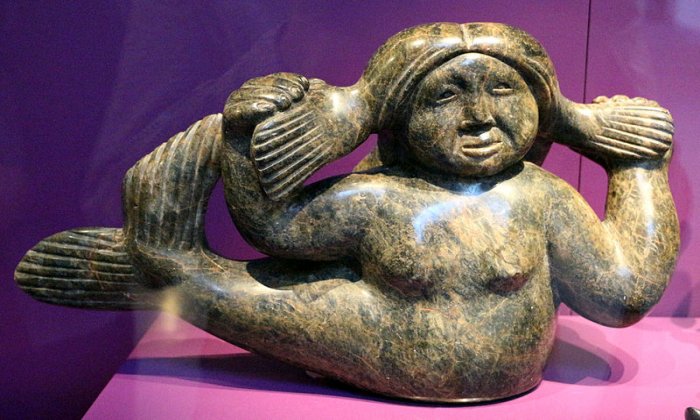Power Of Water In Beliefs Of Ancient Cultures
A. Sutherland - AncientPages.com - People have observed the water and its powers over the centuries and created related myths and legends.
The sea symbolizes the water of the "sea womb," giving birth to the earth and all that lived on it. 'To return to the sea' is 'to return to the mother,' that is, to die. All life arose once in the ocean, reflected in the creation myths of many ancient cultures.
Credit: Adobe Stock - kharchenkoirina
Water has been credited with purification and healing effects. One of many water places associated with healing is the Chalice Well in Glastonbury, England, where people have been using the spring since 3000 BC, glorifying these mineral-rich waters for their healing powers.
In the Vedas, water is "the most maternal" (mâtritamâh). In the beginning, everything was like a sea without light. In India, this element is generally regarded as the preserver of life, circulating throughout nature as rain. The Chinese consider water to be the residence of the dragon because all life comes from water.
Katsushika Hokusai: The Great Wave Off the Coast of Kanagawa. Public Domain
The sea is also a symbol of the unconscious. Many gods, spirits, and monsters are associated with the sea and natural phenomena such as tsunamis and whirlpools.
Deep water represents death and the supernatural. Poseidon's daughter Charybdis was changed into a sea animal and was most likely the personification of a dangerous whirlpool. Sailors who came too close to her risked dying.
Carl Jung (1875 -1961) once said about the sea and the unconscious. "The sea is the favorite symbol for the unconscious, the mother of all living." Christian baptism symbolizes the cleansing and washing of sin. In Hinduism, water is used for bathing and purifying god images in rites.
Poseidon (in Roman: Neptunus) had the power to control all the seas, but he also had a hot temper. He was highly respected by sailors and others who praised him in the hope of keeping this god happy. It guarantees smooth waters and a safe sea journey.
In Inuit mythology, Sedna was the goddess of the sea and the protector of marine animals. She ruled over the underworld of the Inuit. The fishermen worshiped her to make sure of a good catch.
Another god related to water was Nun ("water"), one of the oldest ancient Egyptian gods.
Depictions show him as a bearded man with blue-green skin resembling water. Nun was the god of the watery primeval void, also called "the primeval waters." In Aboriginal myth, the Wandjina Rain Spirit is the controller of the "Seasons" and the bringer of rain, which is crucial for life. Rain makes everything grow; the fruit, the trees, and the grass nourish animals, birds, and people.
The constant movements of the waves symbolize stability, change, joy, or sorrow; tide waves were linked with destruction and re-birth.
Sculpture of Sedna in the National Museum of Finland. Image credit: Sailko - CC BY 3.
In dreams, they are believed to represent fear of change. The river symbolizes fertility, irrigation of our planet, and running water and reflects the creativity of nature and time. It also indicates the border between two worlds – the Land of the Dead and the Land of the Living. In many cultures, some rivers can be sacred, and they can be river gods as well. Styx, for example, is a deity, the river of death, and one of the five central bodies of water that bordered Tartarus in Greek mythology.
In Hindu beliefs, the goddess Ganga represents the holy water of the river Ganges. Ganga and the river are worshipped as one, as this river plays a crucial role in the lives of the millions of Hindus in India. Hapi was the early Egyptian god of the Nile River. He used the Nile's annual floods to feed the land, bring fertility, and provide water, food and the annual flooding of the Nile River.
According to Hindu legends and Puranas, waterfalls (with healing and purifying powers) serve as a bathing place for gods and other celestial beings who visit them.
A waterfall means positive energy, the flow of life, happiness, vigor, and positive thoughts. A waterfall traditionally represents tranquility, peace, and contemplation. In the Shinto faith, waterfalls are sacred, and standing beneath them is said to purify one's soul. In a Shinto shrine, the faithful wash their hands and rinse their mouth with water from a long wooden spoon before praying, putting their hands close to their face, bowing, and meditating.
Flowing water also remains a fundamental element. The Shinto believers say that before diving in the bath or hot springs, purifying oneself by washing is an expression of ancestral body purification rites.
In China, lakes symbolize wisdom, receptiveness, and passivity. In Hinduism and Buddhism, temple lakes represent creation and the transition to the next life.
In many cultures, ponds, pools, and especially springs were believed to be abodes for water sprites, nymphs, or dangerous, prophetic demons.
In the past, water was sometimes a "judge." Women who were suspected of being witches were thrown into deep water. If they drowned, they were innocent. If they floated, however, they could be sentenced to witchcraft.
Water was used in witches' trials because it was believed that this "pure" element, like water, would reject those in league with the devil.
Written by – A. Sutherland - AncientPages.com Senior Staff Writer
Updated on January 3, 2024
Copyright © AncientPages.com All rights reserved. This material may not be published, broadcast, rewritten or redistributed in whole or part without the express written permission of AncientPages.com
Expand for referencesReferences:
Samual Noah Kramer, The Sumerians
Clayton, M. Hindu Mythology
Graves, R. The Greek Myths
More From Ancient Pages
-
 ‘Sesselfelsgrotte Cave’ – Innovative Neanderthals Adjusted To Climate Change By Creating More Complex Tools
Artifacts | Aug 31, 2020
‘Sesselfelsgrotte Cave’ – Innovative Neanderthals Adjusted To Climate Change By Creating More Complex Tools
Artifacts | Aug 31, 2020 -
 Ancient Script Reveals Mysterious Location Of Legendary Hanging Garden Of Babylon
Featured Stories | Apr 4, 2014
Ancient Script Reveals Mysterious Location Of Legendary Hanging Garden Of Babylon
Featured Stories | Apr 4, 2014 -
 Huge Megalithic 7,000-Year-Old Site Dolmen Of Guadalperal Emerges From Dry Lake In Spain
Archaeology | Aug 22, 2022
Huge Megalithic 7,000-Year-Old Site Dolmen Of Guadalperal Emerges From Dry Lake In Spain
Archaeology | Aug 22, 2022 -
 Artifacts Unearthed In Mit-Rahina, South Of Giza, Egypt
Archaeology | Jul 29, 2020
Artifacts Unearthed In Mit-Rahina, South Of Giza, Egypt
Archaeology | Jul 29, 2020 -
 Royal Tombs Of Alexander The Great’s Family At Vergina, Greece Finally Identified
Archaeology | Jan 31, 2024
Royal Tombs Of Alexander The Great’s Family At Vergina, Greece Finally Identified
Archaeology | Jan 31, 2024 -
 Mysterious Ancient Female Society Discovered – What Happened To All The Men? Archaeologists Wonder
Featured Stories | Oct 3, 2024
Mysterious Ancient Female Society Discovered – What Happened To All The Men? Archaeologists Wonder
Featured Stories | Oct 3, 2024 -
 El Volcán: Mysterious Volcano-Shaped Pyramid With Never Revealed Secrets In Peru
Archaeology | Jun 6, 2017
El Volcán: Mysterious Volcano-Shaped Pyramid With Never Revealed Secrets In Peru
Archaeology | Jun 6, 2017 -
 Norse God Tyr Who Gave Viking Warriors Courage And Self-Confidence In Battle
Featured Stories | Mar 7, 2018
Norse God Tyr Who Gave Viking Warriors Courage And Self-Confidence In Battle
Featured Stories | Mar 7, 2018 -
 Artificial Intelligence And Clay Tablets: Not Yet A Perfect Match
Scripts, Paintings & Inscriptions | Oct 12, 2023
Artificial Intelligence And Clay Tablets: Not Yet A Perfect Match
Scripts, Paintings & Inscriptions | Oct 12, 2023 -
 First Look At Mysterious 2,700-Year-Old Underground Frescoes Hidden Inside An Urartu Structure
Archaeology | Oct 6, 2022
First Look At Mysterious 2,700-Year-Old Underground Frescoes Hidden Inside An Urartu Structure
Archaeology | Oct 6, 2022 -
 Hopi’s Encounter With Maasaw – The Skeleton Man And His Gift Of Sacred Knowledge
Myths & Legends | May 5, 2017
Hopi’s Encounter With Maasaw – The Skeleton Man And His Gift Of Sacred Knowledge
Myths & Legends | May 5, 2017 -
 Mystery Of The 290-Million-Year-Old Zapata Footprint In New Mexico
Featured Stories | Sep 23, 2020
Mystery Of The 290-Million-Year-Old Zapata Footprint In New Mexico
Featured Stories | Sep 23, 2020 -
 Experts Restore Ceremonial Boat Of Pharaoh Cheops At On-Site Antiquities Laboratory
Archaeology | Mar 30, 2017
Experts Restore Ceremonial Boat Of Pharaoh Cheops At On-Site Antiquities Laboratory
Archaeology | Mar 30, 2017 -
 Elusive Celtic Otherworld Where Tuatha Dé Danann Reside And Time Passes Slower
Celtic Mythology | Apr 7, 2018
Elusive Celtic Otherworld Where Tuatha Dé Danann Reside And Time Passes Slower
Celtic Mythology | Apr 7, 2018 -
 King Alaric’s Strange Dream, Sack Of Rome And Forever Hidden Grave
Featured Stories | Aug 16, 2024
King Alaric’s Strange Dream, Sack Of Rome And Forever Hidden Grave
Featured Stories | Aug 16, 2024 -
 Ptolemaic-Era Warship Discovered Near The Sunken City Of Heracleion In Alexandria By Underwater Archaeologists
Archaeology | Jul 20, 2022
Ptolemaic-Era Warship Discovered Near The Sunken City Of Heracleion In Alexandria By Underwater Archaeologists
Archaeology | Jul 20, 2022 -
 4,500-Year-Old Ramp Might Explain How Huge Stones Were Transported To Great Pyramids’ Building Site
Archaeology | Nov 9, 2018
4,500-Year-Old Ramp Might Explain How Huge Stones Were Transported To Great Pyramids’ Building Site
Archaeology | Nov 9, 2018 -
 Iron Age Site Of Khok Phutsa Excavated In Thailand
Archaeology | Apr 15, 2019
Iron Age Site Of Khok Phutsa Excavated In Thailand
Archaeology | Apr 15, 2019 -
 DNA Says You’re Related To A Viking, A Medieval German Jew Or A 1700s Enslaved African? What A Genetic Match Really Means
DNA | Jun 7, 2024
DNA Says You’re Related To A Viking, A Medieval German Jew Or A 1700s Enslaved African? What A Genetic Match Really Means
DNA | Jun 7, 2024 -
 Finds From Archaeological Dig Were Deliberately Hidden From The Public, Says Man Who Participated In The Excavations
Featured Stories | Dec 3, 2024
Finds From Archaeological Dig Were Deliberately Hidden From The Public, Says Man Who Participated In The Excavations
Featured Stories | Dec 3, 2024



